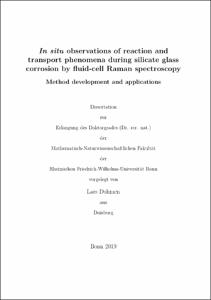In situ observations of reaction and transport phenomena during silicate glass corrosion by fluid-cell Raman spectroscopyMethod development and applications

In situ observations of reaction and transport phenomena during silicate glass corrosion by fluid-cell Raman spectroscopy
Method development and applications

| dc.contributor.advisor | Geisler-Wierwille, Thorsten | |
| dc.contributor.advisor | ||
| dc.contributor.author | Dohmen, Lars | |
| dc.date.accessioned | 2020-07-06T09:49:45Z | |
| dc.date.available | 2020-07-06T09:49:45Z | |
| dc.date.issued | 06.07.2020 | |
| dc.identifier.uri | https://hdl.handle.net/20.500.11811/8435 | |
| dc.description.abstract | Borosilicate glass is the preferred material for the immobilization of high-level nuclear waste and an important material for various industries. Silicate glasses, however, are prone to corrosion by aqueous solutions, which is reflected by the formation of surface alteration layers (SALs) that are assumed to represent a chemically leached, restructured residual glass. However, there are several inconsistencies with this interpretation such as, for instance, (i) the observation of an atomically sharp interface between the SAL and the underlying glass or (ii) the formation of structural and chemical patterns in the SAL, which both cannot be explained by a diffusion-controlled corrosion mechanism. Experimentally, glass-water reactions are typically investigated under controlled experimental conditions in reaction vessels and by the subsequent, post mortem analysis of (i) the experimental solution after quenching it to room temperature and/or (ii) the solid reaction products after quenching, drying, and mechanical sectioning. Quenching is a crucial shortcoming of such a post mortem experimental procedure, since the main corrosion product of silicate glasses is a hydrous amorphous silica gel that undergoes significant chemical and structural changes such as condensation/polymerization, water loss, and/or cracking during cooling and subsequent drying. Moreover, new samples have to be used for each T-t step and quench phases that may not necessarily be involved in the actual reaction are not easily recognized from post mortem analyses. As a matter of fact, a missing component of our current experimental and analytical strategies is the investigation of glass-water reactions at the microscopic to molecular level without disturbing or interrupting them. In this work, novel confocal hyperspectral Raman experiments to in situ study the reaction between two different borosilicate borosilicate glass and alkaline aqueous solutions at 90 °C were performed. Methods are developed to determine the local pH in situ, i.e., space-resolved at the micrometer scale, as well as the local temperature (for experiments in 0.5 M NaHCO3 solution). At the beginning of the reaction, a thin boundary layer at the surface of the glass with higher pH values relative to the bulk solution was observed in several experiments. At this stage the glass dissolved congruently. After the formation of an SAL, an even higher pH within a water-rich interfacial solution located between the SAL and the underlying glass was found. A sudden drop of the reaction rate was observed after the SAL thickness had reached about 30 micrometers. By exchanging the solution with a deuterated bicarbonate solution, the transport of D2O/OD could be followed through the SAL and it was observed that water transport to and from the interfacial solution was not rate-limiting. The obtained in situ data supports an interface-coupled dissolution-reprecipitation model for the formation of the SAL and casts doubts on the validity of published kinetic glass corrosion models. | en |
| dc.language.iso | eng | |
| dc.rights | In Copyright | |
| dc.rights.uri | http://rightsstatements.org/vocab/InC/1.0/ | |
| dc.subject | Borosilikatglas | |
| dc.subject | Wässrige Lösung | |
| dc.subject | Korrosion | |
| dc.subject | Raman-Spektroskopie | |
| dc.subject | Instrumentelle Analytik | |
| dc.subject | in situ-Analytik | |
| dc.subject | Borosilicate glass | |
| dc.subject | Corrosion | |
| dc.subject | Aqueous solution | |
| dc.subject | Raman spectroscopy | |
| dc.subject | Instrumental chemistry | |
| dc.subject | In situ analytical techniques | |
| dc.subject.ddc | 500 Naturwissenschaften | |
| dc.subject.ddc | 540 Chemie | |
| dc.subject.ddc | 550 Geowissenschaften | |
| dc.subject.ddc | 660 Technische Chemie | |
| dc.subject.ddc | 670 Industrielle und handwerkliche Fertigung | |
| dc.title | In situ observations of reaction and transport phenomena during silicate glass corrosion by fluid-cell Raman spectroscopy | |
| dc.title.alternative | Method development and applications | |
| dc.type | Dissertation oder Habilitation | |
| dc.publisher.name | Universitäts- und Landesbibliothek Bonn | |
| dc.publisher.location | Bonn | |
| dc.rights.accessRights | openAccess | |
| dc.identifier.urn | https://nbn-resolving.org/urn:nbn:de:hbz:5-58570 | |
| ulbbn.pubtype | Erstveröffentlichung | |
| ulbbnediss.affiliation.name | Rheinische Friedrich-Wilhelms-Universität Bonn | |
| ulbbnediss.affiliation.location | Bonn | |
| ulbbnediss.thesis.level | Dissertation | |
| ulbbnediss.dissID | 5857 | |
| ulbbnediss.date.accepted | 05.03.2020 | |
| ulbbnediss.institute | Mathematisch-Naturwissenschaftliche Fakultät : Fachgruppe Erdwissenschaften / Institut für Geowissenschaften | |
| ulbbnediss.fakultaet | Mathematisch-Naturwissenschaftliche Fakultät | |
| dc.contributor.coReferee | Konings, Rudy |
Files in this item
This item appears in the following Collection(s)
-
E-Dissertationen (4378)




